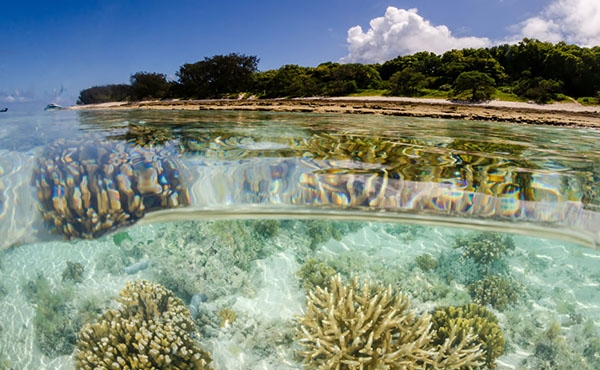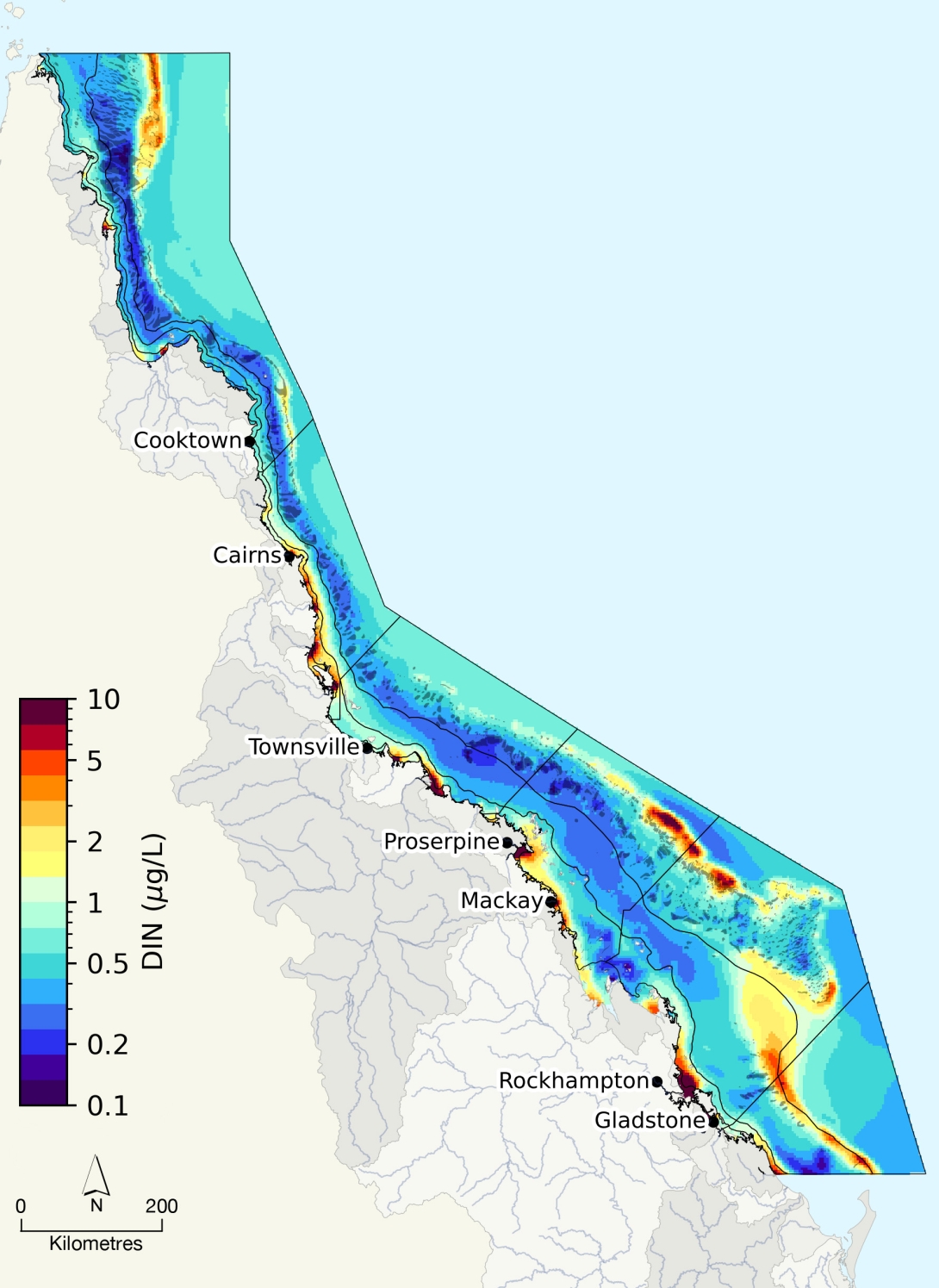74.
Benkwitt, C.E., D’Angelo, C., Dunn, R.E., Gunn, R.L., Healing, S., et al. 2023, Seabirds boost coral reef resilience, Science Advances 9(49).
248.
Robson, B.J., Skerratt, J., Baird, M.E., Davies, C., Herzfeld, M., et al. 2020, Enhanced assessment of the eReefs biogeochemical model for the Great Barrier Reef using the Concept/State/Process/System model evaluation framework, Environmental Modelling & Software 129: 104707.
276.
Diaz-Pulido, G., Reyes-Nivia, C., Adame, M.F., Arthington, A., Collier, C. and Lovelock, C. 2024, 2022 Scientific Consensus Statement: Summary | Evidence Statement for Question 4.2: What are the measured impacts of nutrients on GBR ecosystems, what are the mechanism(s) for those impacts and where is there evidence of this occurring in the GBR? in 2022 Scientific Consensus Statement on land-based impacts on Great Barrier Reef water quality and ecosystem condition, eds J. Waterhouse, M. Pineda and K. Sambrook, Commonwealth of Australia and Queensland Government.
317.
De Goeij, J.M., Van Oevelen, D., Vermeij, M.J., Osinga, R., Middelburg, J.J., et al. 2013, Surviving in a marine desert: the sponge loop retains resources within coral reefs, Science 342(6154): 108-110.
356.
Richardson, A., Eriksen, R., Moltmann, T., Hodgson-Johnston, I. and Wallis, J.R. 2020, State and Trends of Australia’s Ocean Report, Integrated Marine Observing System, Hobart.
696.
Zhang, X., Ward, B.B. and Sigman, D.M. 2020, Global nitrogen cycle: critical enzymes, organisms, and processes for nitrogen budgets and dynamics, Chemical Reviews 120(12): 5308-5351.
697.
Moore, C.M., Mills, M.M., Arrigo, K.R., Berman-Frank, I., Bopp, L., et al. 2013, Processes and patterns of oceanic nutrient limitation, Nature Geoscience 6(9): 701-710.
698.
Arrigo, K.R. 2005, Marine microorganisms and global nutrient cycles, Nature 437(7057): 349-355.
699.
Lønborg, C., Doyle, J., Furnas, M., Menendez, P., Benthuysen, J.A., et al. 2017, Seasonal organic matter dynamics in the Great Barrier Reef lagoon: Contribution of carbohydrates and proteins, Continental Shelf Research 138: 95-105.
700.
Millero, F.J. 2007, The marine inorganic carbon cycle, Chemical reviews 107(2): 308-341.
701.
Bainbridge, Z., Lewis, S., Bartley, R., Fabricius, K., Collier, C., et al. 2018, Fine sediment and particulate organic matter: A review and case study on ridge-to-reef transport, transformations, fates, and impacts on marine ecosystems, Marine Pollution Bulletin 135: 1205-1220.
702.
Crosswell, J.R., Carlin, G. and Steven, A. 2020, Controls on carbon, nutrient, and sediment cycling in a large, semiarid estuarine system; Princess Charlotte Bay, Australia, Journal of Geophysical Research: Biogeosciences 125(1): e2019JG005049.
703.
Skerratt, J.H., Mongin, M., Baird, M.E., Wild-Allen, K.A., Robson, B.J., et al. 2019, Simulated nutrient and plankton dynamics in the Great Barrier Reef (2011–2016), Journal of Marine Systems 192: 51-74.
704.
Fabricius, K.E. 2005, Effects of terrestrial runoff on the ecology of corals and coral reefs: review and synthesis, Marine Pollution Bulletin 50(2): 125-146.
705.
Strzelec, M., Proemse, B.C., Gault-Ringold, M., Boyd, P.W., Perron, M.M., et al. 2020, Atmospheric trace metal deposition near the Great Barrier Reef, Australia, Atmosphere 11(4): 390.
706.
Shaw, E.C., Gabric, A.J. and McTainsh, G.H. 2008, Impacts of aeolian dust deposition on phytoplankton dynamics in Queensland coastal waters, Marine and Freshwater Research 59(11): 951-962.
707.
Benkwitt, C.E., Carr, P., Wilson, S.K. and Graham, N.A. 2022, Seabird diversity and biomass enhance cross-ecosystem nutrient subsidies, Proceedings of the Royal Society B 289(1974): 20220195.
708.
Defforey, D. and Paytan, A. 2018, Phosphorus cycling in marine sediments: Advances and challenges, Chemical Geology 477: 1-11.
709.
Hulth, S., Aller, R.C., Canfield, D.E., Dalsgaard, T., Engström, P., et al. 2005, Nitrogen removal in marine environments: recent findings and future research challenges, Marine Chemistry 94(1-4): 125-145.
710.
Robson, B., Brown, A. and Uthicke, S. 2024, 2022 Scientific Consensus Statement: Summary | Evidence Statement for Question 4.1: What is the spatial and temporal distribution of nutrients and associated indicators within the GBR? in 2022 Scientific Consensus Statement on land-based impacts on Great Barrier Reef water quality and ecosystem condition, eds J. Waterhouse, M. Pineda and K. Sambrook, Commonwealth of Australia and Queensland Government.
711.
Bahadori, M., Chen, C., Lewis, S., Wang, J., Shen, J., et al. 2023, The origin of suspended particulate matter in the Great Barrier Reef, Nature Communications 14(1): 5629.
712.
Frade, P.R., Glasl, B., Matthews, S.A., Mellin, C., Serrão, E.A., et al. 2020, Spatial patterns of microbial communities across surface waters of the Great Barrier Reef, Communications Biology 3(1): 442.
713.
Tang, W., Llort, J., Weis, J., Perron, M.M., Basart, S., et al. 2021, Widespread phytoplankton blooms triggered by 2019–2020 Australian wildfires, Nature 597(7876): 370-375.
714.
Abram, N.J., Gagan, M.K., McCulloch, M.T., Chappell, J. and Hantoro, W.S. 2003, Coral reef death during the 1997 Indian Ocean Dipole linked to Indonesian wildfires, Science 301(5635): 952-955.
715.
Li, M., Shen, F. and Sun, X. 2021, 2019‒2020 Australian bushfire air particulate pollution and impact on the South Pacific Ocean, Scientific Reports 11(1): 12288.
716.
Kleypas, J.A. and Burrage, D.M. 1994, Satellite observations of circulation in the southern Great Barrier Reef, Australia, International Journal of Remote Sensing 15(10): 2051-2063.
717.
Paerl, H.W. 2018, Why does N-limitation persist in the world's marine waters? Marine Chemistry 206: 1-6.
718.
Zehr, J.P. and Kudela, R.M. 2011, Nitrogen cycle of the open ocean: from genes to ecosystems, Annual Review of Marine Science 3: 197-225.
719.
Hutchins, D.A. and Capone, D.G. 2022, The marine nitrogen cycle: new developments and global change, Nature Reviews Microbiology 20(7): 401-414.
720.
Reich, H.G., Tu, W., Rodriguez, I.B., Chou, Y., Keister, E.F., et al. 2021, Iron availability modulates the response of endosymbiotic dinoflagellates to heat stress, Journal of Phycology 57(1): 3-13.
721.
Reich, H.G., Rodriguez, I.B., LaJeunesse, T.C. and Ho, T. 2020, Endosymbiotic dinoflagellates pump iron: differences in iron and other trace metal needs among the Symbiodiniaceae, Coral Reefs 39(4): 915-927.
722.
Jackson, R. and Gabric, A. 2022, Climate change impacts on the marine cycling of biogenic sulfur: a review, Microorganisms 10(8): 1581.
723.
Zehr, J.P. and Capone, D.G. 2020, Changing perspectives in marine nitrogen fixation, Science 368(6492): eaay9514.
724.
Ani, C.J., Smithers, S.G., Lewis, S., Baird, M. and Robson, B. 2023, eReefs modelling suggests Trichodesmium may be a major nitrogen source in the Great Barrier Reef, Estuarine, Coastal and Shelf Science 285: 108306.
725.
Bergman, B., Sandh, G., Lin, S., Larsson, J. and Carpenter, E.J. 2013, Trichodesmium–a widespread marine cyanobacterium with unusual nitrogen fixation properties, FEMS Microbiology Reviews 37(3): 286-302.
726.
Welsh, D.T. 2000, Nitrogen fixation in seagrass meadows: regulation, plant–bacteria interactions and significance to primary productivity, Ecology Letters 3(1): 58-71.
727.
Sheng, H., Wan, X.S., Zou, B., Sun, Y., Hanoch, B., et al. 2023, An efficient diazotroph‐derived nitrogen transfer pathway in coral reef system, Limnology and Oceanography 68(4): 963-981.
728.
Zhou, L., Tan, Y. and Huang, L. 2023, Coral reef ecological pump for gathering and retaining nutrients and exporting carbon: a review and perspectives, Acta Oceanologica Sinica 42(6): 1-15.
729.
Torda, G. and Lewis, B. 2022, The basics of coral biology, in Coral Reefs of Australia: Perspectives from Beyond the Water's Edge, eds S.M. Hamylton, P. Hutchings and O. Hoegh-Guldberg, CSIRO Publishing, Collingwood, pp. 143–148.
730.
Rädecker, N., Pogoreutz, C., Voolstra, C.R., Wiedenmann, J.ö and Wild, C. 2015, Nitrogen cycling in corals: the key to understanding holobiont functioning? Trends in Microbiology 23(8): 490-497.
731.
Morris, L.A., Voolstra, C.R., Quigley, K.M., Bourne, D.G., Bay, L.K. 2019, Nutrient availability and metabolism affect the stability of coral–Symbiodiniaceae symbioses, Trends in Microbiology 27(8): 678-689.
732.
Zhao, H., Yuan, M., Strokal, M., Wu, H.C., Liu, X., et al. 2021, Impacts of nitrogen pollution on corals in the context of global climate change and potential strategies to conserve coral reefs, Science of the Total Environment 774: 145017.
733.
D’Angelo, C., Wiedenmann, J. 2014, Impacts of nutrient enrichment on coral reefs: new perspectives and implications for coastal management and reef survival, Current Opinion in Environmental Sustainability 7: 82-93.
734.
Lapointe, B.E., Brewton, R.A., Herren, L.W., Porter, J.W. and Hu, C. 2019, Nitrogen enrichment, altered stoichiometry, and coral reef decline at Looe Key, Florida Keys, USA: a 3-decade study, Marine Biology 166(8): 108.
735.
Caballes, C.F., Sambrook, K. and Pratchett, M.S. 2024, 2022 Scientific Consensus Statement: Summary | Evidence Statement for Question 4.3: What are the key drivers of the population outbreaks of Crown of Thorns Starfish (COTS) on the GBR, and what is the evidence for the contribution of nutrients from land-runoff to these outbreaks? in 2022 Scientific Consensus Statement on land-based impacts on Great Barrier Reef water quality and ecosystem condition, eds J. Waterhouse, M. Pineda and K. Sambrook, Commonwealth of Australia and Queensland Government.
-
737.
Steven, A.D., Baird, M.E., Brinkman, R., Car, N.J., Cox, S.J., et al. 2019, eReefs: an operational information system for managing the Great Barrier Reef, Journal of Operational Oceanography 12(sup2): S12-S28.
738.
Kroon, F.J., Crosswell, J.R. and Robson, B.J. 2023, The effect of catchment load reductions on water quality in the crown-of-thorn starfish outbreak initiation zone, Marine Pollution Bulletin 195: 115255.




